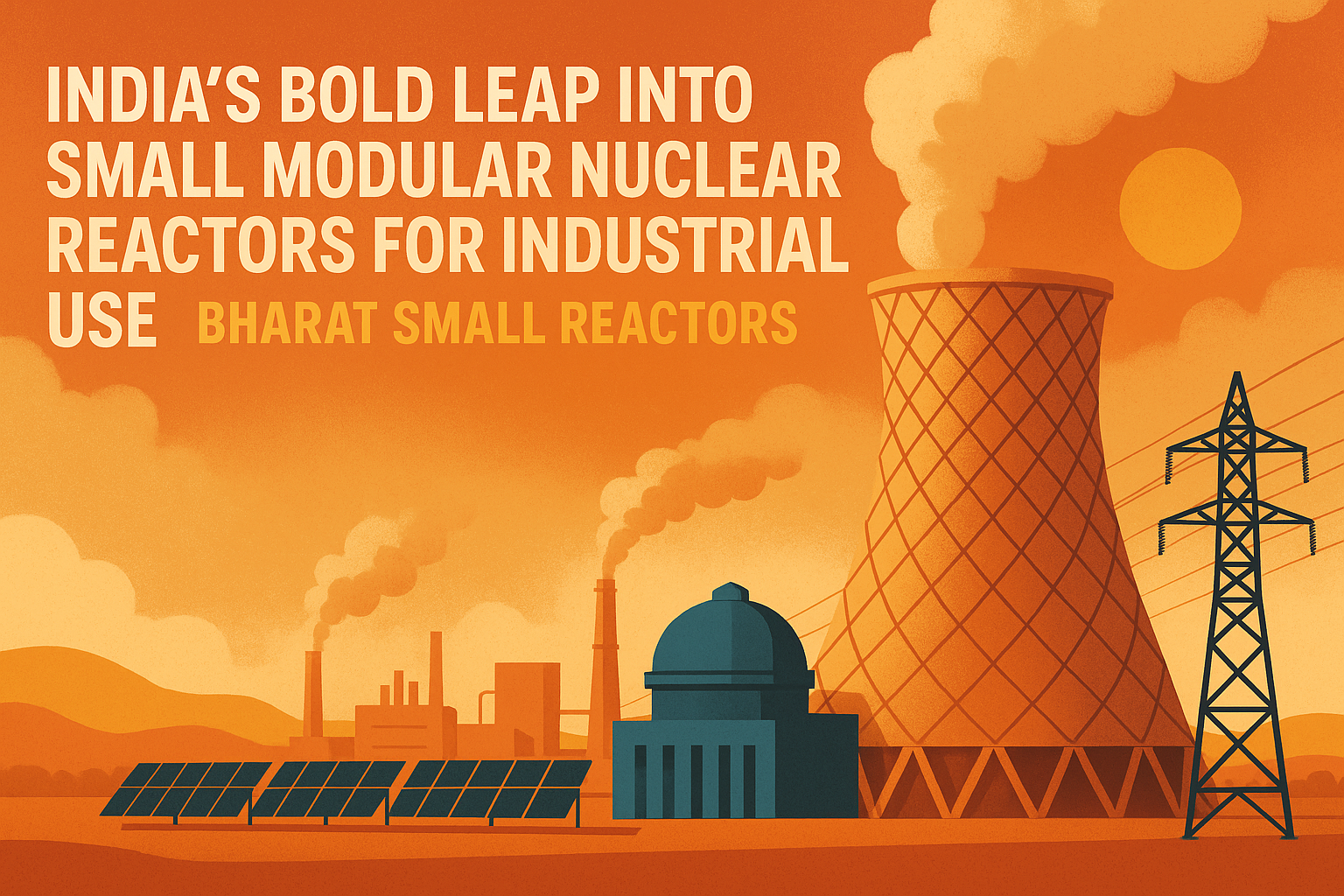India’s energy landscape is witnessing a strategic and transformative shift with the launch of the Bharat Small Reactors (BSRs) program—an ambitious initiative to set up small modular nuclear reactors (SMRs) for captive industrial use. With a clear eye on decarbonization and energy independence, this program represents not just a technological pivot but a structural revolution in how India powers its future industries.
🔬 What Are Bharat Small Reactors (BSRs)?
BSRs are compact 220-MWe Pressurized Heavy Water Reactors (PHWRs), designed to offer nuclear power tailored for industrial consumption. Unlike large centralized reactors, these SMRs require less land, are modular, and can be deployed faster—making them ideal for energy-intensive industries seeking a clean and stable power source.
In BSRs, heavy water is used as both a coolant and a neutron moderator, enhancing safety and efficiency. Their manageable size reduces complexity while maintaining the performance required for continuous industrial operations.
🏭 Who’s Lining Up?
India’s top industrial giants have responded enthusiastically to the Request for Proposal (RFP) floated by Nuclear Power Corporation of India Ltd (NPCIL). Among them:
- Reliance Industries
- Adani Group
- Indian Railways
- Greenko
- Vedanta
- HPCL-Mittal Energy Ltd (HMEL)
- JSW Group
- Hindalco Industries
These companies, all large captive power consumers, have the energy appetite, capital muscle, and operational sophistication to run nuclear facilities under NPCIL’s guidance.
📊 The Deal Structure
The model proposed under NPCIL’s RFP is a public-private operational hybrid:
- Construction & Operation: The private user funds and manages construction, operation, and eventual decommissioning.
- Ownership Transfer: The reactor is transferred to NPCIL for Re ₹1 upon completion.
- Beneficial Ownership: The industrial user retains exclusive rights to the generated electricity.
- Operational Management: NPCIL will operate the reactor and charge a nominal 60 paise/kWh (in 2030-31), increasing by 1 paise/year.
- Eligibility: Minimum power requirement of 2,500 MUs/year, net worth of ₹3,000 crore, and a high credit rating.
A tripartite agreement among the user, NPCIL, and the Department of Atomic Energy (DAE) will govern fuel and heavy water supply, with all associated costs borne by the industrial user.
🌱 Green Energy, Strategic Vision
This initiative is a keystone in India’s roadmap to reach net-zero carbon emissions by 2070. From an installed capacity of 8.78 GW, India aims to expand nuclear capacity to:
- 22.48 GW by 2030
- 100 GW by 2047
BSRs serve as a carbon-free baseload power source, suitable for replacing coal-based generation in industrial clusters.
The plan also aligns with the surge in power demand from AI data centers, crypto mining, and high-efficiency manufacturing, all of which need low-carbon, reliable, and 24/7 power—a sweet spot for nuclear energy.
💰 Capital Cost vs Long-term Gains
The upfront cost of nuclear remains high—₹16-20 crore/MW compared to coal (₹9-10 crore), solar (₹4.5-5.3 crore), and wind (₹6.5-7.8 crore). But nuclear excels in low operational costs, high capacity utilization, and consistent output, giving it an edge in total lifecycle economics.
A report by SBI Caps underscores this, highlighting nuclear’s cost competitiveness when storage is factored into the cost of renewables.
🔧 What’s Next?
The roadmap involves:
- MoU signing between NPCIL and industrial users.
- Site feasibility studies and state-level land reclassification.
- 99-year land lease agreement for NPCIL.
- Definitive agreements and fuel arrangements via DAE.
At least five BSRs are expected to be operational by 2033, and the Electricity Rules, 2005 are being amended to grant them captive generating plant status. If electricity is sold externally, tariffs will be regulated under the Atomic Energy Act, 1962.
🌍 Global Vision, Local Innovation
India’s expertise in PHWRs—home to 20 of the 24 commercial nuclear reactors in operation—has gained international traction. There’s growing interest in exporting BSRs to African nations grappling with power shortages due to climate change impacts on hydropower.
The upcoming Nuclear Energy Mission, with a ₹20,000 crore allocation under FY26, and the ₹1 trillion R&D boost from FY25’s interim budget, underscore the government’s long-term commitment to nuclear energy.
🚀 Conclusion
The BSR initiative is not just an energy policy—it’s a strategic, environmental, and economic reimagination of India’s industrial future. By marrying public-sector nuclear expertise with private-sector agility, India is crafting a nuclear-powered renaissance that could shape the global SMR narrative for decades to come.
The age of compact, clean, and reliable nuclear energy has dawned—and India is not just a participant but a potential leader.
Feel free to share your experiences and insights in the comments below. Let’s continue the conversation and grow together as a community of traders and analysts.
By sharing this experience and insights, I hope to contribute to the collective knowledge of our professional community, encouraging a culture of strategic thinking and informed decision-making.
As always, thorough research and risk management are crucial. The dynamic nature of financial markets demands vigilance, agility, and a deep understanding of the tools at your disposal. Here’s to profitable trading and navigating the election season with confidence!
Ready to stay ahead of market trends and make informed investment decisions? Follow our page for more insights and updates on the latest in the financial world!
For a free online stock market training by Yogeshwar Vashishtha (M.Tech IIT) this Saturday from 11 am – 1 pm, please sign up with https://pathfinderstrainings.in/training/freetrainings.aspx
Experience profits with my winning algo strategies – get a free one-month trial with ₹15 lakh capital! – https://terminal.algofinders.com/algo-terminal
Disclaimer
This article should not be interpreted as investment advice. For any investment decisions, consult a reputable financial advisor. The author and publisher are not responsible for any losses incurred by investors or traders based on the information provided.


